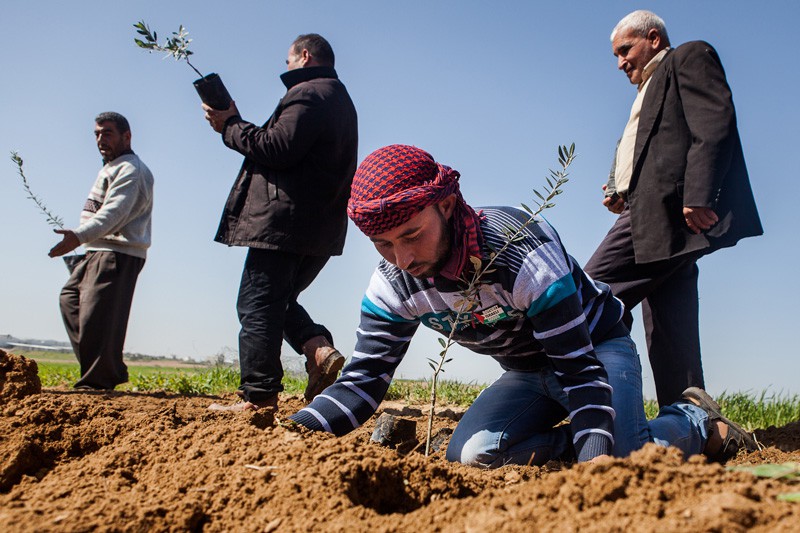
“Both of the fishermen captured today have returned to their homes,” explains Zakaria Baker in his home in Gaza’s crowded al-Shati refugee camp the night of February 20.
Baker, an activist with the Union of Agricultural Work Committees (UAWC), oversees the organization’s committees of fishers in five cities in the Gaza Strip.
“Their boat is in Ashdod, and the Israelis shot the motor,” he adds.
Three days later, the two fishers recount their experience in the sandy courtyard of their family’s home in the northern town of Jabalia. They are surrounded by a dozen relatives, with a similar number of children clustered outside an iron gate.
“Suddenly the Israeli navy came with two small ships, with between five and seven soldiers per boat,” says Mohammed Shehda Sadalla.
“The captain of one of the boats ordered us to drop our nets and swim to the navy ships. We protested, telling them that we were in Palestinian waters. They said, ‘Shut up or we will shoot you.’ We didn’t follow his orders but went to the engine and turned it on. Then one of the soldiers shot it.”
Facing lethal violence, Mohammed and his younger cousin Mahmoud Moussa Sadalla followed the soldiers’ orders, removing their clothes and swimming through the cold sea to the naval vessel. Once on board, Mohammed says, they were blindfolded and shackled, then transferred to a larger ship that took them to the Israeli port of Ashdod.
After medical testing, soldiers drove them to the Erez checkpoint where they were questioned about their work, their neighbourhoods, and the Gaza seaport. “They took our names, ages, and addresses. Then they showed us an exact picture of the roof of our home on a computer.”
The interrogators tried to recruit them as collaborators. “They asked us about our economic situation and how much we earned per day and if we could help each other,” says Mohammed. He and Mahmoud were released through the checkpoint into the Gaza Strip later that evening.

The Gaza Strip, a coastal stretch of 360 square kilometres, sits at the crossroads of Africa and Asia. One of the world’s most densely populated territories, it contains 1.7 million people, two-thirds of them refugees driven from their homes in Palestine by Zionist militias, and later the Israeli army, during the State of Israel’s 1948 founding. It shares a narrow southwestern border with Egypt’s Sinai Peninsula and is surrounded on every other side by Israel or the Mediterranean Sea, which is constantly patrolled by the Israeli navy.
Israel has occupied the strip since 1967, but dismantled its settlements in Gaza and redeployed its ground forces in 2005. However, it kept control of the territory’s borders, seaways, and airspace, as well as its banking and telecommunications systems, its imports and exports, population registry, and even the issuance of building permits to international organizations. In 2007, Israel imposed a crippling siege. In addition to a nautical blockade, it sharply reduced the goods allowed through checkpoints under its control, ending nearly all agricultural exports from the Gaza Strip.
It also reasserted its buffer zone policy, typically enforced with live gunfire. Previously it had banned Palestinians from coming within 150 metres of the barrier separating the Gaza Strip and Israel or sailing more than six nautical miles offshore. By 2008, the buffer zone had grown to encompass a 300-metre-wide strip of land around the territory and all but three nautical miles offshore.
These areas included over 35 per cent of the Gaza Strip’s agricultural land and, many say, all of its fisheries. “From zero to eight miles there are no fish,” says Mohammed al-Bakri, general manager of UAWC in the Gaza Strip.
UAWC, founded in Jerusalem in 1986, organizes farmers and fishers in the Gaza Strip and the West Bank into agricultural and fishing committees. “We have 16 local committees for farmers,” says Sa’d Eddin Sha’ban Ziada, who coordinates the UAWC’s agricultural committees in Gaza. “We have another five for fishermen.”
Altogether, al-Bakri says, the Gaza Strip committees include 5,125 farmers, fishers, and other agricultural workers.
“We need strong local committees that can represent their societies,” says Ziada. “We support them through several training programs to build their capacity: leadership, teamwork, need assessment, gender, advocacy and community mobilization, organizing syndicates, documenting Israeli attacks, and food sovereignty. UAWC insists on these bodies being strong.” In addition to its organizing work, UAWC supports farmers and fishers with projects like home gardens, water carriers, and aquaculture programs.

Despite UAWC’s efforts, Israel’s restrictions have taken a heavy toll. Between 2007 and 2009, the Gaza Strip’s agricultural workforce fell by 42 per cent even as food insecurity had reached 61 per cent of the population. By November 2011, the Gaza Strip held only 3,097 registered fishers, down from about 10,000 in 2000.
A one-sided ceasefire
On November 14, 2012, Israeli forces used an aerial drone to assassinate Ahmed al-Jabari, Gaza Strip commander of Hamas’ Izz ad-Din al-Qassam Brigades. Eight days of Israeli airstrikes and drone bombings, artillery fire, and naval shelling, answered with rocket fire by resistance groups in the Gaza Strip and mass demonstrations in the West Bank, followed. By November 21, when a ceasefire between Israel and the Palestinian resistance group Hamas took hold, six Israelis and 186 Palestinians – including two in the West Bank – had been killed.
The first line of the Egypt-brokered deal read: “Israel shall stop all hostilities in the Gaza Strip land sea and air, including incursions and targeting of individuals.” The text went on to promise Israel’s “refraining from restricting residents’ free movements and targeting residents in border areas.” The next day, the Palestinian government in Gaza announced that the fishing limit had returned to six nautical miles, and farmers began cautiously exploring the 300-metre buffer zone.
“After the ceasefire, the local government told farmers that their land was open,” says al-Bakri. “After they had cultivated it, Israeli bulldozers entered and destroyed it.”
As for fishers, Baker says they had even less of a reprieve. “In the three days after the ceasefire, four small boats with engines and one trawler were captured. One small boat was bombed and destroyed. The motors of two others were shot.
“Since November 24, five boats have been captured, five have been shot, and three fishermen have been injured.”
The experiences of these farmers and fishers reflect those of Gaza Strip residents as a whole. In the three months following the ceasefire, British journalist Ben White found that Israeli military attacks killed four Palestinians and wounded 91. Israeli forces launched 63 shooting attacks on the Gaza Strip and 13 military incursions into its land, as well as 30 naval attacks on fishers.
Meanwhile, Palestinian resistance groups kept their part of the deal, to “stop all hostilities from the Gaza Strip against Israel, including rocket attacks and all attacks along the border.” Aside from two mortars launched from the Gaza Strip after Israeli attacks in December, the ceasefire held – if only one way – until the morning of February 26, when Fatah’s al-Aqsa Martyrs’ Brigades fired a rocket into Israel in what the group called a “preliminary response” to the death of its member Arafat Jaradat, allegedly under torture, in Israel’s Megiddo prison three days earlier.
Fishers say most attacks on them since the ceasefire have occurred within six nautical miles of the shore. But according to al-Bakri, the new limits remain insufficient. “After the ceasefire, they only opened the sea three more miles,” he says. “There are no fish in these three miles. It is the same. They just wanted to show the international community Israel giving something to the Palestinians. The situation is the same; the market is the same. Nothing has changed in the life of the fishermen.”
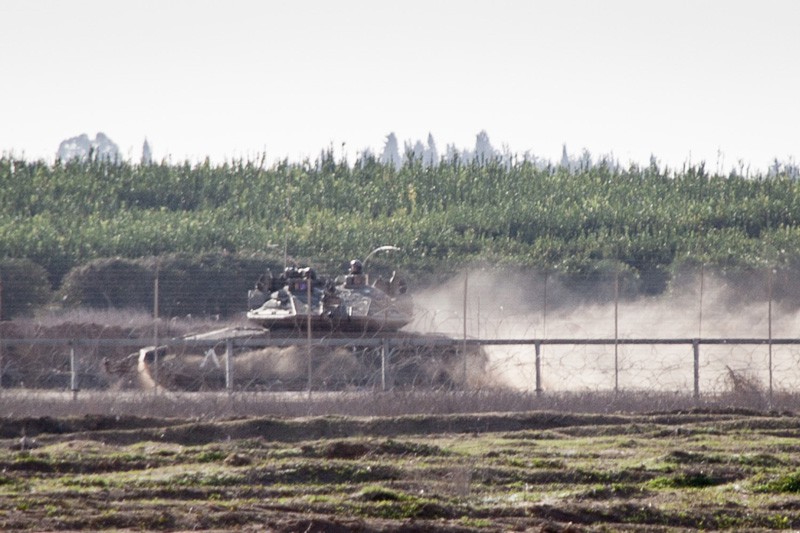
On March 21, the Israel Defense Forces spokesperson announced that the fishing limit would again be reduced to three nautical miles.
Farmers, he says, face small improvements for certain crops. “Some of them plant wheat close to the buffer zone. They’re afraid they won’t be able to cultivate it.”
In the Gaza Strip, farmers often plant crops according to their distance from Israel’s concrete walls and sniper towers: those requiring the least attention are planted closest. “From 50 to 150 metres, we can grow wheat,” says Ammar Saleh el-Rahel, a strawberry farmer in Beit Lahia. “After 150 metres, we can grow potatoes. This depends on how much water the crops need. We don’t have to take care of wheat or potatoes every day. And their harvest only takes a day or two. We risk our lives to grow these crops to gain any possible profit.”
El-Rahel’s rented 1.2-hectare farm lies 400 metres from the separation barrier – not far enough, he says, to save the expensive plastic sheets used to cover rows of strawberries at night from being shredded by bullets during the November attacks. And because he was unable to remove the sheets over eight days, about 80 per cent of the harvest was destroyed. “This wasn’t only for me but for all the strawberry farmers in the area.”
“We need a clear decision from the international community,” says al-Bakri. “Most of them talk about development programs for the buffer zone.” In the West Bank, UAWC organizes farmers into agricultural co-operatives to distribute their products effectively. But in the Gaza Strip, Israel’s siege has all but eliminated agricultural exports. Through its partnerships with 16 international non-governmental organizations, UAWC has launched new projects to help local farmers remain on their lands.

Near the buffer zone, al-Bakri says, many donors see these as poor investments, a perception Israel does little to discourage. “Representatives from several European countries went to the buffer zone a few weeks ago to inspect a site where they wanted to implement a project,” he says. “Israeli troops shot at them to scare them away and discourage them from developing any new infrastructure here.”
In the short term, he adds, “we don’t wait for Israeli decisions about this area. We support the farmers who are going to the buffer zone to exercise their rights to use it. We know that the Israeli bulldozers may come later and destroy it. But we have to say to the international community, ‘These are our rights. This is our land.’ ”
Boycotts are working
It is because of the uncertainty, Ziada says, that UAWC emphasizes political engagement. “We seek to push for farmers and fishermen to have a say and voice their opinions.”
He recites events for which the local committees have mobilized hundreds of participants: Prisoners’ Day, Nakba Day, Land Day, Labour Day, a festival supporting Gaza’s Samouni family (which lost 21 relatives to Israeli attacks in January 2009), a rally for fishers in the seaport, and a protest of the Palmer Report, which denied Israeli guilt for its attack on the 2010 Freedom Flotilla.
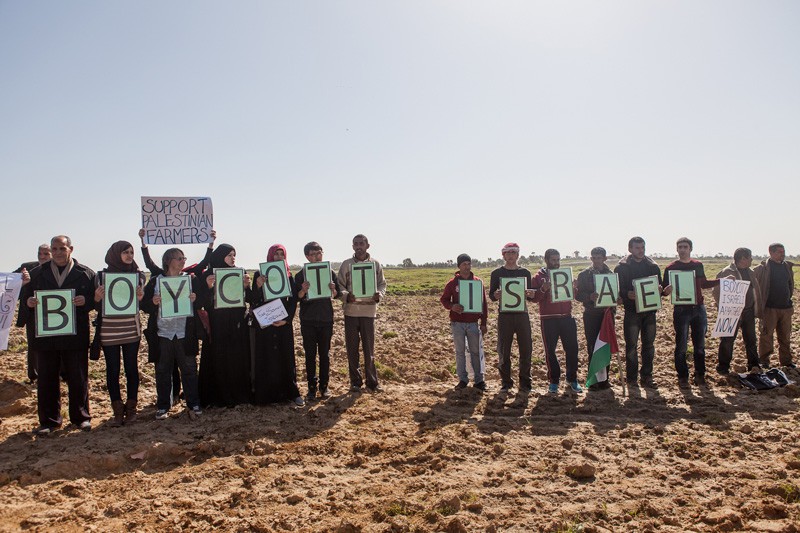
For its most recent demonstrations, UAWC joined protesters in the West Bank and 40 European cities to support a boycott of Israeli agricultural companies. Gaza events, which lasted several days, ended with a February 9 march, rally, and mass planting of olive trees in the buffer zone. On March 3, several hundred fishers sailed a flotilla of over 50 boats from the Gaza seaport to the northern town of Beit Lahia to protest Israeli naval attacks and confiscation of fishing vessels.
“To make pressure, we need a boycott of the Israelis by the international community,” al-Bakri says. “Only this will force them to allow Palestinians to use our lands and waters.”
But he thinks international reactions show UAWC’s mobilizations are working. “When I receive phone calls from Belgium, Norway, Italy, and England … it means our voice is raised and people know the issues.”


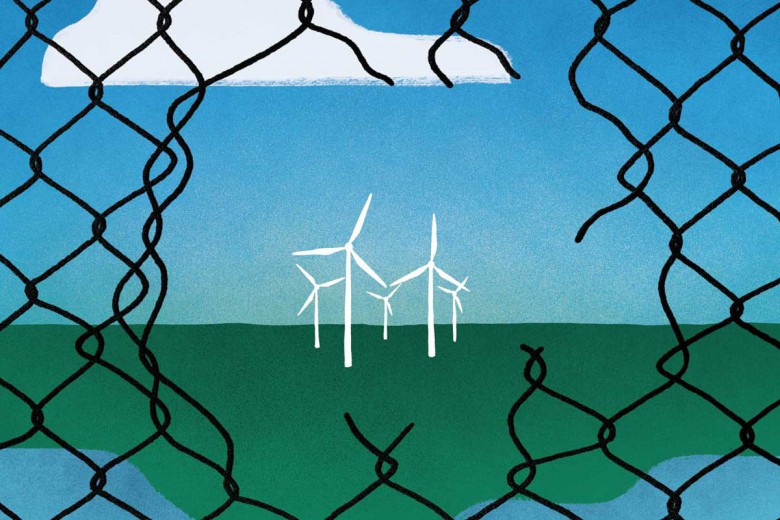
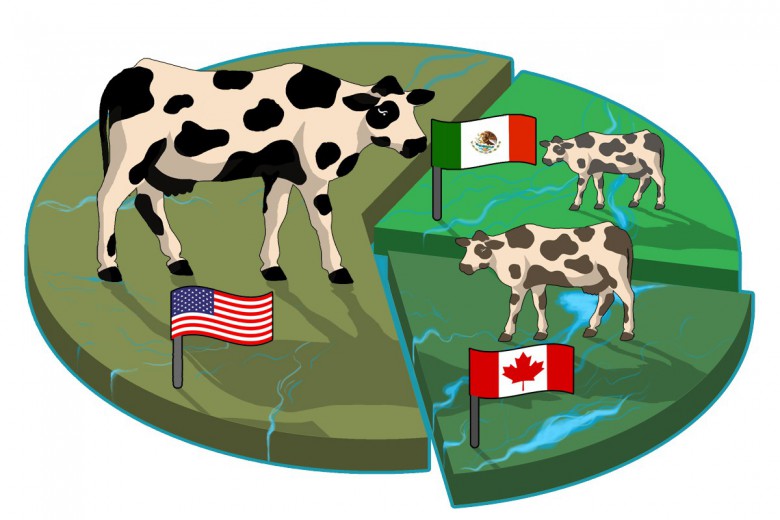

_780_520_90_s_c1_c_c.jpg)
